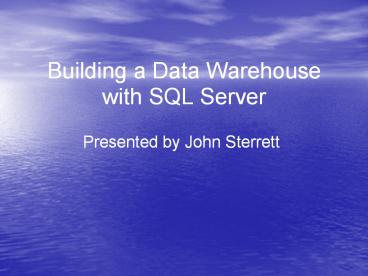Building a Data Warehouse with SQL Server - PowerPoint PPT Presentation
Title:
Building a Data Warehouse with SQL Server
Description:
... values and a large number of patients to ... Star Schema Example. Facts and Measures. Fact table consists of at least two types of data: keys and measures. ... – PowerPoint PPT presentation
Number of Views:364
Avg rating:3.0/5.0
Title: Building a Data Warehouse with SQL Server
1
Building a Data Warehouse with SQL Server
- Presented by John Sterrett
2
About Me
3
AITP - Pittsburgh
http//www.aitp-pgh.org/
4
What is a data warehouse?
Building a Data Warehouse with SQL Server
5
What is Business Intelligence?
- According to Wikipedia BI refers to skills,
technologies, applications and practices used to
help a business acquire a better understanding of
its commercial context. - The following is a definition from Business
Intelligence with Microsoft Office
PerformancePoint Server 2007 - Business intelligence (BI) is more of a concept
than a single technology. The goal is to gain
insight into the business by bringing together
data, formatting it in a way that enables better
analysis, and then providing tools that give
users powernot just to examine and explore the
data, but to quickly understand it.
6
Data Warehouse Business Intelligence
7
Business Problems that BIAddresses
- Slow-to-execute queries
- General system slowdowns
- Manual query writing
- Disparate data sources
- Data is not available to all users
- Too much data
8
What is BI to the users?
- BI is fast to query.
- BI improves your return on investment (ROI)
- BI is a tool that allows users to find what they
need.
9
Business Cases
- A technology department could analyze work
completed for departments and/or clients. This
could then be used to estimate future flat fee
engagements, establish seasonal hiring, balance
overtime. - A medical center could use statistics covering a
wide range of lab values and a large number of
patients to identify whether a patient currently
being treated might be at an elevated risk for a
certain types of disease. - Application thats great for data entry but lacks
in depth reporting and drilldown capabilities. - A company who wants to centralize data to a
single data source for allowing decision makers
the ability to make decisions as needed.
10
What Products Are Involved?
- Database Technologies
- SQL Server 2005/2008 (Database Engine)
- SQL Server Analysis Services (SSAS)
- SQL Server Integration Services (SSIS)
- User Interface Technologies
- SQL Server Reporting Services (SSRS)
- SQL Server Management Studio (SSMS)
- Performance Point 2007
- SharePoint
- Excel
11
DEMO!
- Browse a Cube using Management Studio
12
Goals for dimensional modeling
- Understand star schema
- Understand dimensional modeling
- Understand changing dimensions
- Understanding fact (or measure) and cube modeling
13
Star Schema
- A star schema consists of at least one fact table
and a number of dimension tables. - Star Schema is highly recommended schema for SSAS
cubes.
14
Star Schema Example
15
Facts and Measures
- Fact table consists of at least two types of
data keys and measures. - Keys are usually surrogate keys that link to the
dimension tables. - Measures are numeric values that are usually
additive that express business metrics.
16
Dimensions
- Dimensions describe who, what, when, where and
why for the facts. - Dimensions should consist of the following data
types - Surrogate key.
- Primary key of the loaded source(s)
- Any additional attributes (columns) that
describe the business entity.
17
Dimension Examples
18
Slowly Changing Dimensions (SCD)
19
Hierarchies
- Hierarchies serve two purposes
- Convenience for end users.
- Provides drill down / drill up features
20
Where do I go from here?
- Create Use Grain Statements
- What are the key metrics for your business?
- What factors do you use to evaluate those key
metrics? - What level of granularity do you use evaluate
each factor?
21
Grain Statement Examples
- We want to see time worked, hours billed, and
cost of work by date, by employee, by department,
by location, and by projects. - We want to see sales amount and sales quantity by
day, by product, by employee, and by store
location. - We want to see average score and quantity of
courses taken, by course, by day, by student, by
manager, by curriculum, and by curriculum type.
22
DEMO
- Build a Cube
23
Extracting Loading Data
- The process of extracting, transferring and
loading data consumes about 75 of the Data
Warehouse project. - It is highly recommended to use SSIS for ETL
instead of native T-SQL
24
Basic Dimension Package
25
Basic Fact Package
26
So You are interested in building a Data
Warehouse
- Click here to download a Virtual PC that
includes sample Data Warehouses and all of
Microsofts BI tools. - If you already have SQL Server 2005 and Analysis
Services configured click here to download
samples (Click here for SQL Server 2008) - Check out this Introduction to Data Warehousing
with SQL Server
27
Q/A
- Blog www.johnsterrett.com
- LinkedIn www.linkedin.com/in/johnsterrett
- Twitter www.twitter.com/johnsterrett
- E-Mail jsterrett_at_gmail.com
28
References
- Foundation of SQL Server 2005 Business
Intelligence. - Business Intelligence with Microsoft Office
PerformancePoint Server 2007 - ACM Intro to Data Warehousing

